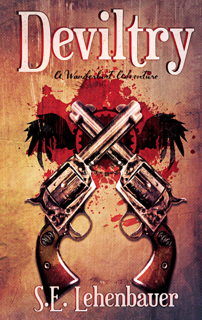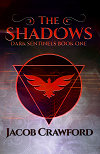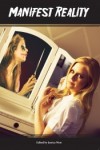GOD, we are just so, so clever over here.
Anyway. Here we go, gang: We’ve got a very special treat today: The amazing and wonderful S.E. Lehenbauer has graced us with her virtual presence via a guest blog post! She’s discussing some great viewpoints on diversity in literature, and how natural that really is. So enjoy, and be sure to read Deviltry–I can vouch for its excellence! ![]()
——-
Hello Ravenhart blog readers! It is I, the Batman.
No, wait! I mean, NOT the Batman. Shhhhhhh….
By day, I am S.E. Lehenbauer, the author of Deviltry. (By night, I am absolutely not fighting crime in a rubber suit.) Deviltry is the first in the Wanderlust Adventures, a series of novellas that follow the crew of the spacecraft Wanderlust in a reimagined 1800s. Earth is now Terra Fragmentum, a collection of small worlds that were once our planet as we knew it. Aliens, cowboys (and girls!), and moon-based royalty come together to create a great big ball of fun.
I didn’t start out with any idea of diversity when creating this series. The genesis of the project was an RPG character that I created many moons ago. Her name was Sally Carson. Because we were playing a western-themed game, I made her the daughter of Kit Carson. Later, she became more complex by being his daughter via a Cheyenne woman named Making-Our-Road (Kit Carson’s real life wife for a while). I was just picking up historical facts about Kit that I found interesting; I didn’t consider the fact that I was making a diverse character at the time.
Fast forward to last year, when I began writing Sally’s adventures as a space cowgirl. Her crew includes a Mexican woman, a gay man, and Sally herself is bisexual. Regina was based on a woman I knew as a teenager; likewise, Noah and Sally’s sexual orientations are reflections of personal circumstances in my own life. The moon princess became a POC because at the time I was bing-watching Doctor Who, and I liked the idea of Martha Jones as a space princess. No idea why. The diversity within the story was a natural, organic thing that I had no part in creating.
Which is why I was uncomfortable the first time someone pointed it out to me. The recent cry for “diversity in fiction” is an important one; but as with any well-supported idea consisting of lots of voices, I think the point sometimes gets lost with the “movement”. I haven’t said much about my own thoughts on diversity and fiction, and because it wasn’t a conscious decision to include those ideas, I felt like it was a bit false of me to suddenly come forward and point out the diverse factors within Deviltry.
That isn’t to say that it didn’t please me when I realized how diversity had evolved in the story. Whether it happens because of conscious decision or because of some organic thing, ultimately I don’t think it should be ignored. Within the world of the Wanderlust series, three types of diversity are highlighted: gender, race, and sexual orientation. There are many, many more types that are being written right now, types that I would love to see more of: disability, trans*, religions and cultural diversity, the list goes on forever.
On sexual orientation: It can be scary to dive into some of these ideas. Sally is bisexual. I created her as an RPG character during a time when I was going through a lot of personal identity discovery. As you’ve probably guessed, I also identify as queer, and playing as her in a game helped me embrace that part of myself. When it came time to write her stories, it didn’t occur to me to change or downplay that part of her personality. It’s who she is, and it brings a lot of interesting tension certain scenes. However, being mostly closeted in real life, and living in a fairly conservative area of the United States, I worried. I fretted. I came close to editing out all instances of her bisexuality—surely, I reasoned, the readers don’t actually need to know. But what it came down to was that to remove that part of Sally was to be untrue to her, and to the story, which translates into being untrue to my readers.
On race: This was the aspect that made me the most nervous when releasing Deviltry. Due to Sally’s history, and her feelings towards her mother who abandoned her, she has a few sarcastic moments where she refers to the Cheyenne as “savage natives” or “barbarians”. I hope, pray, that my readers can see that her racism is coming from a place of hurt, and I also hope that they’ll trust me when I swear that those issues get fully examined throughout the series. As far as the rest of the characters in the world, those that present as non-white are honestly just products of their environments. I knew that Sally had history in Mexico, and that having a Mexican crew member would bring that conflict to a head. I knew that I wanted the crew to visit Japan (if only because of my life-long fascination with geisha and samurai), thus including Japanese characters only made sense. Others are based on real people: Wade, the mechanic who we’ve only seen off-screen so far, is Greek because he’s based on an old high school teacher of mine who made an impact on my writing. As I said above, the Princess was an homage to Martha Jones. Buck, Noah, and Tyler, are all inspired by old friends.
On gender: Sally is, clearly, female. As are Regina and the Princess, who becomes a larger figure later. In passing, it would appear that Deviltry really isn’t that diverse in regard to gender. Looking at my notes, out of the next dozen major characters to be introduced, 8 of them are women. Perhaps that break down came as a natural result of me being a woman. A lot of these people are based on historical figures, and I tend to be drawn to interesting women in history. I am honestly less interested in how many women are included, and more interested in what kinds of women and their relationships. I like to see women that can save the day. I like to see women that can’t save the day. I like to see friendships between women that don’t dissolve in catty fighting; I like to see women having platonic friendships with men. I like to see damsels in distress being saved by tough cowgirls. I like to see wilting flowers learn to be stronger, and butch, kick-ass ladies learn to be a little softer. In short, I like real people. Just focus on making them real, the diversity will follow.
To end on a personal note, I just want to say that writing diversity isn’t hard. It shouldn’t be hard. I did it on accident! Writing a world filled with people just like the ones you know and see every day will automatically produce a diverse world. It’s the nature of what is around you. I think that, rather than attempt to fill any sort of quota, writers concerned about diversity should instead work to improve their observation skills of the world. As a friend of mine put it recently:
“If it’s natural to write, it’s natural to read. And that’s way better than a writer going ‘so I need 40% of my characters to be black or Hispanic, 5% to be Asian, 10% to be disabled and/or queer’…” Write naturally, my friends. Don’t force it.
Thank you for letting me invade your blog today, Ravenhart friends. Deviltry is out now from a wide array of book sellers. You can find links and more information here: www.selehenbauer.com/books/
I must go now. My city needs me.
*flies away into the night*






Pingback: Guest Post: Creative History: On Building Deviltry | Writing Possibilities